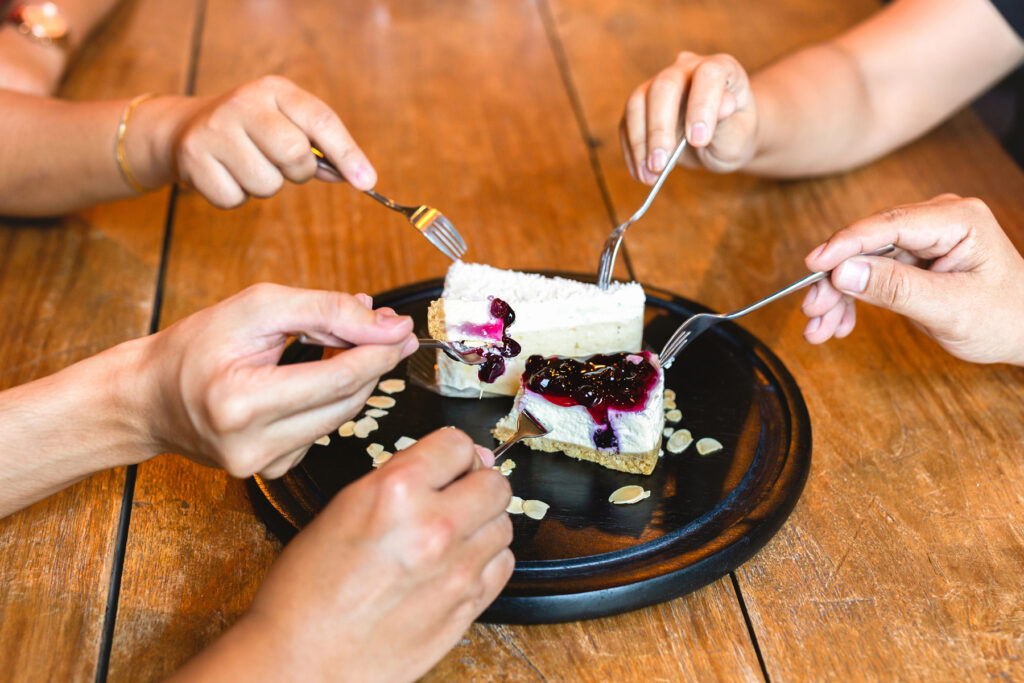Bake or no-bake. Vanilla, cherry, or chocolate. Classic, modern, or DIY (Do It Yourself).
Cheesecake has so many versions that it’s impossible to keep track. Maybe it’s called cheesecake, torte, tart, or pie? How about New York-Style, Japanese Ube, French Tarte au Fromage, or Israeli (made with gevina levana cheese)? Try vegan, savory, or air-fryer. Top with whipped cream, syrup, fruit . . . just about anything that sounds good. Cheesecake is iconic, complete with countless stories, versions, and loyalists.
Like me.
Whether I get my slice from The Cheesecake Factory or Junior’s, homemade, or from a local restaurant or bakery, it’s hard to find bad cheesecake.
The best is rich, creamy, and melts-in-your-mouth. What’s Cooking America? maintains that “ever since the dawn of time, mankind has striven to create the perfect cheesecake.”
Quite a claim.
Cheese production began thousands of years ago before recorded history. Experts believe that cheese was discovered by accident in Egypt. Who knows? Maybe they were trying to make the perfect cheesecake in a mud-brick hut?
Ancient Greece boasted the first recorded history of this beloved food. Katie Straw writes in The Daily Slice that people living on the Greek Isle of Samos pounded cheese “into a thick paste,” sweetened it with honey and put it into a “crust of wheat.” It was baked, cooled, and very happily eaten.
Cheesecake was offered as a tribute to the gods. It was served at weddings to celebrate love. Food historians believe that small cheesecakes were given to athletes for strength and endurance in the first Olympic Games, roughly 776 BCE.
When the Romans conquered Greece and its islands, the recipe fell into their hands. Straw writes that they made their own version called Libum “with results very similar to modern cheesecake.” It included cheese, honey, eggs, and wheat.
The Romans spread the recipe throughout Europe.
King Richard II commissioned the first English cookbook in 1390, called The Forme of Cury. It contained a recipe for Sambocade (cheesecake). Dan Nosowitz writes in Wondrous Foods that sambocade was made from “cheese curds, egg whites, sugar, dried elder flower (seen as medicinal at the time), and rosewater” baked in a pie crust.
From Forme of Cury, 1390, compliments of Wikimedia Commons
Germany created käsekuchen, using quark (a cheese made from soured milk). The Dutch made a gingersnap-style cookie crust and the Italians used ricotta or mascarpone.
Get the picture?
Step into Chester, NY, 1872. Dairyman William Lawrence was trying to create an American version of French Neufchâtel – a soft, mold-ripened cheese. He added too much cream and ended up with a richer product – cream cheese.
He called it Neufchâtel & Cream Cheese.
Demand was huge. By 1880 the name was changed to Philadelphia Cream Cheese. Today, according to Statista, annual sales are about $323 million.
It’s also known for winning the Guinness Record for World’s Largest Cheesecake. Weighing 6,900 pounds, the humongous cheesecake contained 24,533 servings.
That’s some mouthful.
Cream cheese gave rise to the modern cheesecake. New Yorkers fell in love with the dessert. Arnold Reuben (who originated the Reuben Sandwich) claimed credit for creating the iconic New York Style Cheesecake (sometimes called the Jewish Cheesecake). The recipe was simple, pure, made with cream cheese, cream, eggs, and sugar. What’s Cooking America reports that “according to New Yorkers, only the great cheesecake makers are located in New York.”
Bakers who make Chicago-style and Roman-style cheesecake, along with hundreds of chefs, might argue the point. After all, today you get fruity, sweet and salty, nutty, spicy chocolate, very berry – there’s no end to the list. You can also get those multiflavored “cakes” that include up to 12 different-flavored slices. If that’s too much, stick to mini cheesecakes or bites.
For the more adventurous, go for a savory cheesecake. It has ingredients like blue cheese, seafood, even tofu. Try salmon/dill and garlic/herb; mushroom/bacon and balsamic/red onion. You can’t go wrong.
Whether classic or modern, sweet or savory, baked or not baked, cheesecake is a treasure that belongs to all of us.
Enjoy!






What fun! I’m not sure about the savory cheesecake, especially the salmon one, but I suppose I won’t knock it until I’ve tried it! I just feel like sweet cheesecake is such a treat, why mess with it? Then again, I agree, there’s no such thing as bad cheesecake, sweet or savory… Does that make me a cheesecake loyalist like you?? Wonderful article, and thanks for the great lesson!